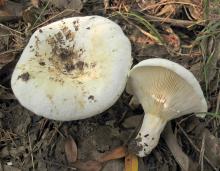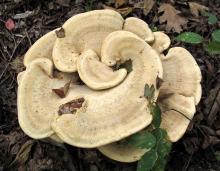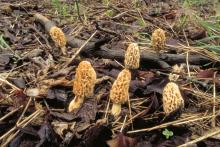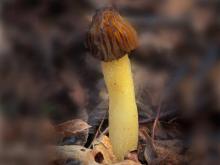Mushrooms
Media

Species Types
Scientific Name
Lactarius piperatus
Description
The peppery milky has a white cap with densely crowded gills. It bleeds white and has a spicy-hot taste. It grows scattered in deciduous woods.
Media

Species Types
Scientific Name
Grifola frondosa
Description
Looking like a ruffled chicken, the edible hen of the woods mushroom grows like large circular bouquet of spoon-shaped caps, each grayish brown on top and white beneath, emerging from a branching, whitish base. It grows on the ground at the base of oak trees.
Media

Species Types
Scientific Name
Meripilus sumstinei (formerly M. giganteus)
Description
The black-staining polypore grows in large, circular clusters of many fleshy, grayish yellow, fan-shaped caps, which bruise black when cut or touched. It grows on the ground around deciduous trees, especially oaks.
Media

Species Types
Scientific Name
Bondarzewia berkeleyi
Description
Berkeley’s polypore grows in rosettes or clusters of fleshy, cream-colored caps, with whitish pores that descend the stalk. Look for them on the ground near the bases of trees.
Media

Species Types
Scientific Name
Amanita spp. (about 600 species, worldwide)
Description
This large group of mushrooms accounts for 90 percent of mushroom-related deaths, so every mushroom hunter should be familiar with amanitas. They contain one of the deadliest poisons found in nature!
Media

Species Types
Scientific Name
Morchella species
Description
Favorites among Missouri wild edibles, true morels only appear in the spring. They're very hard to see, but that's part of the fun of hunting them. Learn to identify them, and you can enjoy the hunt, too.
Media

Species Types
Scientific Name
Morchella punctipes (formerly M. semilibera)
Description
The half-free morel is an excellent edible mushroom. It's completely hollow. It has a honeycombed cap with brownish black ridges and yellowish brown pits. The bottom half hangs free from the whitish stalk.
Media

Species Types
Scientific Name
Morchella esculentoides (formerly M. esculenta)
Description
The yellow morel is a choice edible mushroom. It has a honeycombed cap with yellow to grayish to tan ridges and pits. It is completely hollow and grows in the spring.
See Also



Media

Species Types
Scientific Name
Monotropa hypopitys
Description
Pinesap is a plant that puts the "wild" in wildflower! It lacks chlorophyll, so its roots connect to fungi underground and absorb nutrients from the fungi.
Media

Species Types
Scientific Name
Cladophora, Pithophora, and Spirogyra spp., and others
Description
Filamentous green algae forms green, cottony masses that are free-floating or attached to rocks, debris, or other plants.
Media

Species Types
Scientific Name
Monotropa uniflora
Description
Indian pipe lacks chlorophyll, so it is white, not green. Below ground, its roots join with fungi that connect to tree roots. This plant, then, takes nourishment indirectly from the trees.
About Mushrooms in Missouri
Mushrooms are a lot like plants, but they lack chlorophyll and have to take nutrients from other materials. Mushrooms are neither plants nor animals. They are in a different kingdom — the fungi. Fungi include the familiar mushroom-forming species, plus the yeasts, molds, smuts, and rusts.
Always be cautious when eating edible mushrooms. Be absolutely sure of the ID, and only eat a small amount the first time you try it to avoid a reaction..





















